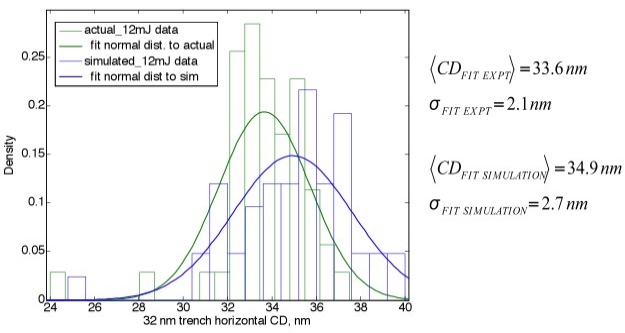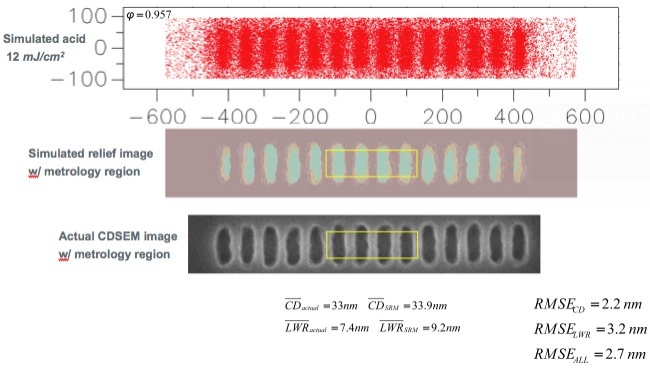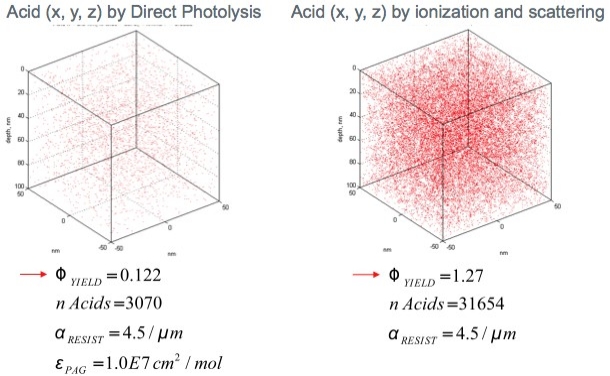by Debra Vogler, senior technical editor, Solid State Technology
February 22, 2010 – KLA-Tencor Corp.’s latest generation of its PROLITH virtual lithography tool, PROLITH X3.1, takes aim at the skyrocketing R&D expenses being incurred at the 1X and 2Xnm nodes. With researchers exploring several possible contenders — double-patterning, EUV, and spacer pitch splitting — the tool’s algorithms uses "first-principle physics" to help researchers investigate and optimize advanced lithography processes, by simulating patterning results rather than printing test wafers. The new EUV and LER models provide results in just a few minutes, Sanjay Kapasi, product marketing manager at KLA-Tencor, told SST.
"Scientists are consistently faced with the difficult task of reducing resist exposure dose and LER while simultaneously improving exposure latitude, depth-of-focus, and ultimate resolution," said Kapasi. Until now, he explained, modeling strategies for optical lithography have generally applied the continuum or mean-field approximation to the physical world being simulated. "However, the real world is discrete," he said; "light energy is quantized into photons and chemical concentrations are quantized into molecules." In the past, the features of interest have been large enough to ignore this distinction, but "it is inevitable that as dose decreases and feature shrink, stochastic effects such as roughness and CD variability will become dominant."
 |
| Figure 1. Reasonable prediction of the horizontal CD distribution by stochastic simulation. Simulated vs. experimental CD distribution at EUV. 32nm trench, 64nm pitch, 12mJ/cm2; 2nm serifs, horizontal CD; 13.5nm, NA=0.3, 0.55/0.35 annular. |
The company’s new approach is to build the quantization of light and matter directly into the simulator — i.e., stochastic modeling — which "allows the user to predict responses that arise from natural statistical fluctuations in optical lithography, such as LER, line width roughness, and CD variability (Figures 1-2)," according to the company.
 |
| Figure 2. Stochastic simulation of 32nm trenches; 64nm pitch, no serifs. 13.5nm, 12mJ/cm2, NA=0.3, 0.55/0.35 annular. |
Kapasi further noted that the absorption of high-energy EUV photons by a resist can produce the photoelectron effect (Figures 3-4). "While absorption of the incident photon is localized to an atomic site, the ejected photoelectron and Auger secondary electrons liberated by inelastic collisions can redistribute the photon energy spatially, producing a photoelectron blur," he stated. "Acid generators in EUV resists are hypothesized to be activated by inelastic collisions with secondary electrons some distance from the photon absorption site, suggesting that quantum yields greater than 1 may be possible." It is also possible, he further explained, to have a reduction of the contrast of the projection image. So the new tool includes a discrete, stochastic photoelectron simulator for the comprehensive study of lithography and resist behavior at EUV.
 |
| Figure 3. Discrete acid yield and electron scattering from one EUV ionization event. |
PROLITH X3.1 also enables intuitive wafer topography set-up and improved wafer topography models that allow for fast, easy evaluation of double and single patterning non-planar lithography stacks, and next-generation non-planar devices such as FinFETs.
 |
| Figure 4. Discrete acid generation at EUV: photolysis vs. ionization and electron scattering. Reported sizing doses in resists EUV cannot be explained by a direct photolytic mechanism, but may be explained by consideration of ionization and electron scattering. 13.5nm, dose =10mJ/cm2, B=4.5/μm, open frame, 0.25NA, 0.9sigma. |
Acknowledgment: All figures are from J. Biafore et al., "Pattern prediction in EUV resists," SPIE Lithography Asia 2009, Proc. SPIE, Vol. 7520, 75201P (2009).

